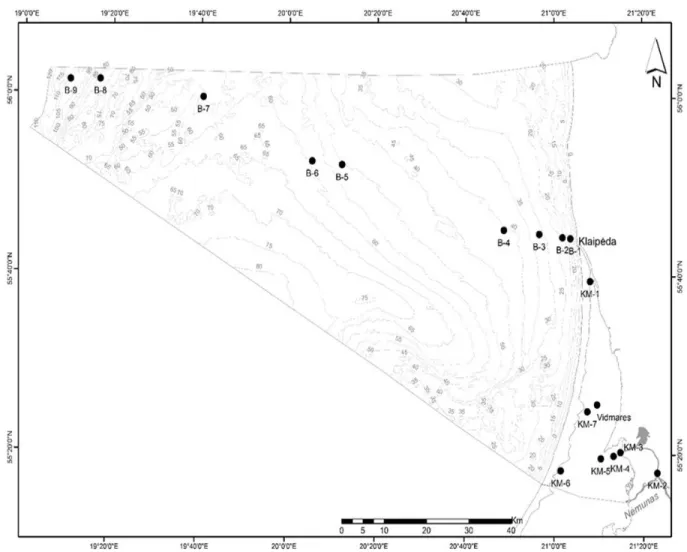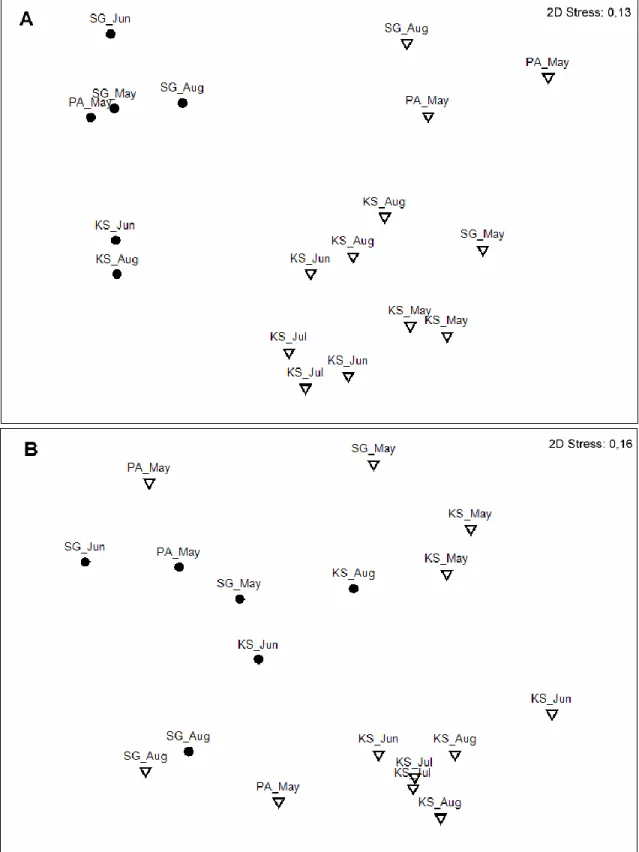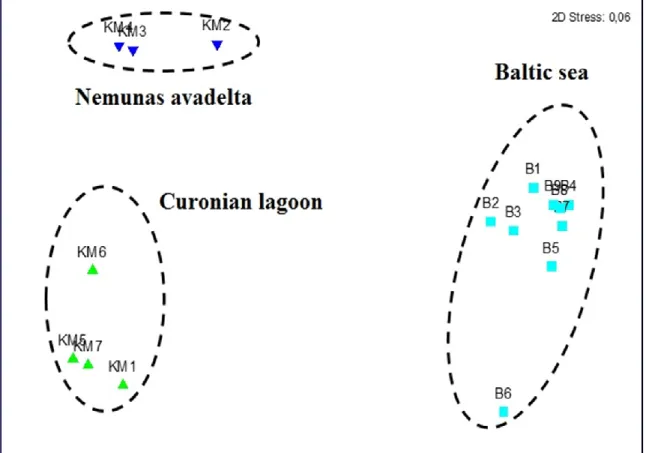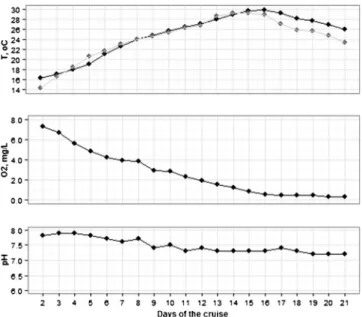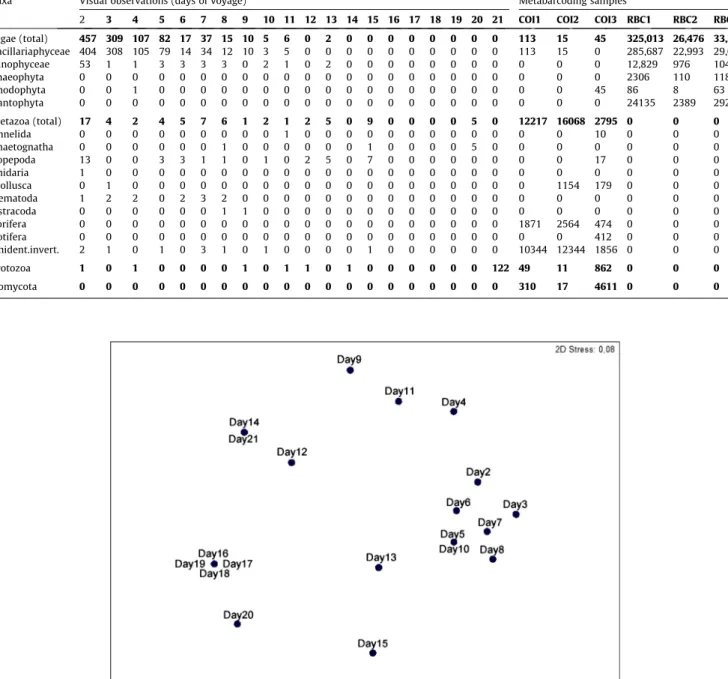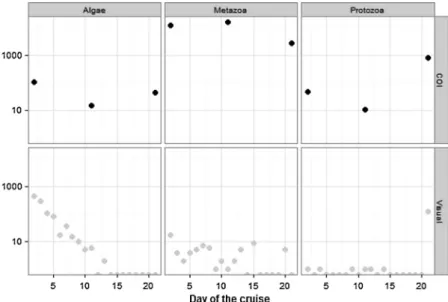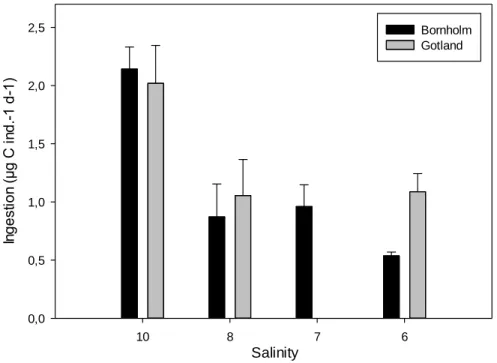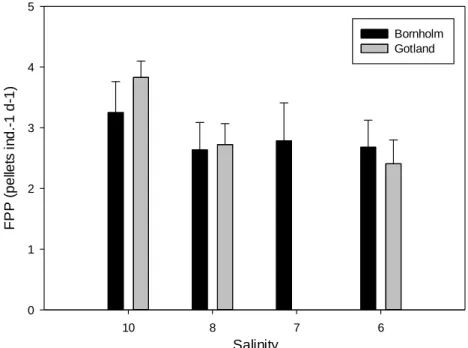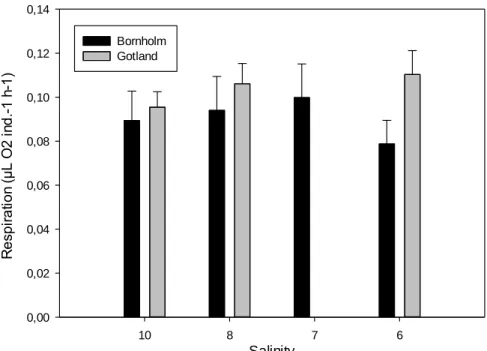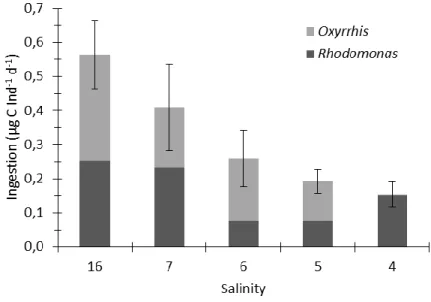1
BIO-C3
Biodiversity changes: causes, consequences and management implications
Deliverable No: 1.2 Workpackage number and leader: 1.2, Catriona Clemmesen-B., P1 Date:
29.02.2016Delivery due date: 29.02.2016
26 monthTitle:
Documentation on key drivers and physiological tolerance limits for residentand invasive species
Lead partner for deliverable:
Catriona Clemmesen-Bockelmann (P1) GEOMAR KielOther contributing partners
P1 (GEOMAR), P2 (DTU Aqua), P3 (UHH-IHF), P4 (SU), P6 (UT-EMI), P7 (SYKE), P8 (KU-CORPI),Authors
C. Clemmesen-Bockelmann, J. Behrens, A. Christensen E.A. F. Christensen J. Dutz, C. Jaspers, E. Flindt, E. Griniene, C. Günther, J.P. Herrmann, H.-H. Hinrichsen, B. Huwer, K.
Karlsson, S. Kolodzey, J. Kotta, H. Kuosa, M. Lehtiniemi, S.
Matern, L. Meskendahl, F. Mittermayer, K. Nurkse, H.
Ojaveer, C. Petereit, S. Puiac, R. Puntila, A. Samuiloviene, A. Temming, M. van Deurs , M. Winder, A. Zaiko
Dissemination level (PU=public, PP=Restricted to other programme participants, including the BONUS Secretariat, CO=confidential)
PU
Nature of the Deliverable (RE=Report, OT=Other)
REAcknowledgements
The research leading to these results is part of the BIO-C3
project and has received funding from BONUS, the joint
Baltic Sea research and development programme (Art 185),
funded jointly from the European Union’s Seventh
Programme for research, technological development and
demonstration and from national funding institutions.
2
BIO-C3 overview
The importance of biodiversity for ecosystems on land has long been acknowledged. In contrast, its role for marine ecosystems has gained less research attention. The overarching aim of BIO-C3 is to address biodiversity changes, their causes, consequences and possible management implications for the Baltic Sea. Scientists from 7 European countries and 13 partner institutes are involved. Project coordinator is the GEOMAR Helmholtz Centre for Ocean Research Kiel, Germany, assisted by DTU Aqua, National Institute of Aquatic Resources, Technical University of Denmark.
Why is Biodiversity important?
An estimated 130 animal and plant species go extinct every day. In 1992 the United Nations tried countering this process with the "Biodiversity Convention". It labeled biodiversity as worthy of preservation – at land as well as at sea. Biological variety should not only be preserved for ethical reasons: It also fulfils key ecosystem functions and provides ecosystem services. In the sea this includes healthy fish stocks, clear water without algal blooms but also the absorption of nutrients from agriculture.
Biodiversity and BIO-C3
To assess the role of biodiversity in marine ecosystems, BIO-C3 uses a natural laboratory:
the Baltic Sea. The Baltic is perfectly suited since its species composition is very young, with current salt level persisting for only a few thousand years. It is also relatively species poor, and extinctions of residents or invasions of new species is therefore expected to have a more dramatic effect compared to species rich and presumably more stable ecosystems.
Moreover, human impacts on the Baltic ecosystem are larger than in most other sea regions, as this marginal sea is surrounded by densely populated areas. A further BIO-C3 focus is to predict and assess future anthropogenic impacts such as fishing and eutrophication, as well as changes related to global (climate) change using a suite of models.
If talking about biological variety, it is important to consider genetic diversity as well, a largely neglected issue. A central question is whether important organisms such as zooplankton and fish can cope or even adapt on contemporary time scales to changed environmental conditions anticipated under different global change scenarios.
BIO-C3 aims to increase understanding of both temporal changes in biodiversity - on all levels from genetic diversity to ecosystem composition - and of the environmental and anthropogenic pressures driving this change. For this purpose, we are able to exploit numerous long term data sets available from the project partners, including on fish stocks, plankton and benthos organisms as well as abiotic environmental conditions. Data series are extended and expanded through a network of Baltic cruises with the research vessels linked to the consortium, and complemented by extensive experimental, laboratory, and modeling work.
From science to management
The ultimate BIO-C3 goal is to use understanding of what happened in the past to predict what will happen in the future, under different climate projections and management scenarios: essential information for resource managers and politicians to decide on the course of actions to maintain and improve the biodiversity status of the Baltic Sea for future generations.
3
Table of content
1. Executive Summary BIOC3 Task 1.2 ……….. 4
1.1 Zooplankton ………... 4
1.2 Invasive/non-indigenous species ………. 5
1.3 Fish and climate change ………. 6
2. Introduction BIOC3 Task 1.2 ……… 8
3. Core activities ……… 8
4. Methods and results ... 9
5. Scientific Highlights ……… 10
5.1 Community level responses and invasive zooplankton species performance along gradients ………. 10
5.2 Physiological tolerance: Temora longicornis – Acartia longiremis ………. 10
5.3 Physiological tolerance to temperature and salinity change of a key copepod species in the Baltic Sea - Eurytemora affinis ……….. 11
5.4 Mnemiopsis leidyi - range expansion salinity and temperature limits ………….. 11
5.5 Effects of natural environmental conditions and shipping on the distribution of the invasive round goby ……… 11
5.6 Differences in the invasive round goby (Neogobius melanostomus) populations in the Baltic Sea ……… 12
5.7 Salinity tolerance of round goby ……… 13
5.8 Salinity and temperature effects on egg development in round goby & Hand line survey in the Western ……… 13
5.9 Temperature and size-dependent functional response of sprat, Sprattus sprattus L ……….….. 13
5.10 Another critical period: the importance of timing of the early juvenile stage for the potential growth performance in Baltic sprat ……….. 14
5.11 Fish egg - buoyancy– experimental and field approach ………. 14
5.12 Cod larvae – populations across geographical scales – experiments ……… 15
6. Progress and next steps ……… 16
7. References ………. 16
8. List of appendices ………. 17
9. Appendices I – IX ……… 19
4
1. Executive Summary BIOC3 Task 1.2
This deliverable is part of WP 1, “Genetic adaptation and eco-physiology”, which investigates physiological tolerances and adaptive variation of key Baltic Sea species. The goal is to provide a general understanding of principal determinants of the distribution of species and populations, which ultimately determine the functional diversity and resilience of Baltic Sea ecosystems in response to environmental drivers. WP1 output will feed into WP2, 3 and 4, and is therefore crucial for the incorporation of evolutionary processes into future projections of the Baltic Sea.
The Baltic Sea experienced large changes in community composition, yet it is largely unknown how these changes affect ecosystem functioning and how organisms are able to cope regarding physiological tolerance, preference and phenotypic plasticity in relation to environmental factors. To help answer these questions, a series of experiments and field studies have been performed for a range of different species including invasive/non- indigenous ones at different positions in the food web.
1.1 Zooplankton
Zooplankton as a critical link for energy and nutritional transfer from phytoplankton to upper trophic levels as well as microzooplankton as another important part in the food web.
Understanding physiological tolerance and zooplankton responses to predicted climate change in the Baltic Sea is a prerequisite for prediction of change in biodiversity. It was decided in this task to specifically look at the responses of offshore deep basin copepods (Acartia and Temora), as well as nearshore coastal copopods (Eurytemora). The results show that females of two different populations of Acartia longiremis originating from the Arkona and the Bornholm Basins displayed a broad salinity tolerance. Survival, feeding and egg production were strongly related to salinity and decreased with decreasing salinity. A salinity of 5 is critical to the population of
A. longiremiswith regard to the species vital rates.
Although females were still able to produce some eggs at this salinity and survival was generally high, the rate of reproduction is likely too low to sustain populations in the Baltic and account for additional mortality by predation. At a salinity of 4 decreased feeding rates were not sufficient anymore to sustain reproduction and high survival of the species. This suggests that the species might not be robust enough for the anticipated worst-case changes in salinity values in the central Baltic Sea (e.g., Meier et al. (2012)).
The comparison of survival to instantaneous changes in salinity suggests that population differences of
A. longiremis exist in the physiological ability to respond to salinity changes.Female copepods originating from a salinity of 14-16 PSU in the Arkona Basin displayed a
higher mortality to the reduction of salinity to 6 and 5 compared to females isolated at a
salinity of 7.8 in the Bornholm Basin. However, female copepods from Bornholm that were
acclimated to salinities of 6-4 before their response to instantaneous reduction in salinity
was tested, displayed no differences in sensitivity to low salinity and had a broad salinity
tolerance. Such difference between populations may be caused by the use of those females
surviving the acclimation to low salinity. Nevertheless, more than 70% of females from
Arkona Basin survived the instantaneous reduction of salinity from 16 to 5 after 5d of
incubation. This indicates physiological and potentially genetic diversity exists in the Arkona
population that allows the species to prosper in areas with lower salinity such as the
Bornholm Basin. Investigations of reaction norms and common garden experiments are
5
required to evaluate this and will be continued in the project and reported in Deliverable 1.3.
Experiments with individuals of the coastal copepod (Eurytemora affinis) from three different areas in the Baltic sea (Askö, Pärnu Bay (part of Gulf of Riga) and Bothnian Bay) revealed how survival, development time and hatching success are affected by temperature, salinity and the interaction between these two environmental factors. Our results revealed the most beneficial and detrimental conditions, and the manner in which stress manifested on our endpoints. Depending on the degree of stress to which they were subjected, the optimum condition proved to be at an experimental temperature of 15°C and a salinity of 6, while the combination of high temperature with low salinity was the most detrimental (20°C and salinity 2). Osmotic and heat shock has been shown for
E. affinis and has beenassociated with changes in protein expression. Even though copepods can adapt to osmotic stress by osmoregulation, it is costly in terms of energy and dependent on the degree of stress. Considering this, our findings for the survival analysis suggest that at 15°C and a salinity of 2 and at a temperature of 20°C and a salinity of 6 the degree of stress was intermediate between the lowest (15°C and salinity of 6) and highest (20°C and salinity of 2).
The information gained from this study helps to get a better insight into functioning of the pelagic system and relevant responses in the higher trophic levels.
Within the project a comprehensive micro- and mesozooplankton survey in the Lithuanian water has been conducted along at salinity gradient where largest change in pelagic patterns are expected, By providing the data on the zooplankton distribution within the Lithuanian coastal zone as an example, new knowledge on spatial and temporal zooplankton variability was achieved.
1.2 Invasive/ non-indigenous species:
Besides the comb jelly,
Mnemiopsis leidyi, which is going to be dealt with in Task 2.3, thebenthic fish species, the round goby (Neogobius melanostomus) was in the focus in our studies. This is because the introduction of an efficient predator, that has become a dominant element in many shallow water ecosystems, is likely to change the abundance of benthic organisms across many trophic levels; they could also modify the physical environment and thereby modulate ecosystem processes such as nutrient fluxes, primary production and sedimentation rates. As the species is not monitored data on its current spread and environmental tolerance is needed. The current range of the round goby observations is extensive, covering all major sub-basins of the Baltic Sea. The most recent observations appeared in the northern regions (Northern Baltic Proper, the Gulf of Bothnia and the Gulf of Finland) and on the eastern and western coasts of southern Sweden.
Modelling results show that the distribution of the round goby is primarily related to local
abiotic hydrological conditions (wave exposure). Furthermore, the probability of round goby
occurrence was very high in areas in close proximity to large cargo ports. This links patterns
of the round goby distribution in the Baltic Sea to shipping traffic and suggests that human
factors together with natural environmental conditions are responsible for the spread of NIS
at a regional sea scale. The hand line survey demonstrated the occurrence of round goby at
the Baltic coastline of Schleswig Holstein. This revealed that the actual position of the
invasion front is in the area of Kiel Bight. Results based on physiological tolerance and
aerobic scope (AS, the difference between maximum and standard metabolic rate)
measurements suggest that round goby has the capacity to occupy full oceanic
6
environments. Therefore, we predict that the species will continue to spread into the Baltic Sea-North sea transition zone, although the depressed physiological performance at high salinities might reduce its competitive potential as it approaches the North Sea. However, a pronounced high inter-individual variation in physiological performance at the highest salinities suggests that some individuals are able to offset the negative effects of high salinity, thus increasing the dispersal potential at the invasion front. According to our results, round and black goby do not compete for food.
1.3 Fish and climate change
What are potential drivers of change, which may affect survival, development, duration or (spatial) distribution of early life stages of cod, sprat and other commercially important key species? To address some of these complex processes we have selected, (partly preliminary) results from three case-studies. The objective of the first study was to compare the potential dimensions of egg buoyancy differences over several spawning seasons to assess general patterns. The objective of the second study was to investigate the importance of different oxygen and salinity conditions in relation to the available habitat determined by the eggs´
specific density. This is particularly interesting by comparing different hydrographic conditions which have recently been changed due to the Major Baltic Inflow (MBI) end of 2014. The third case study is an example how to use field-derived egg diameter data in combination with buoyancy data and to link this with stock characteristics to improve the current estimation method of a spawning stock biomass.
In sprat, egg survival is reduced due to critical temperature conditions, which act as the main driver. Being a “large” egg early (April) in the spawning season might not be optimal for sprat; being “small” at that time however, increases thermal survival conditions in a still tolerable environment concerning oxygen. This size-pattern turns into the other direction in the continuation of the spawning season in May/June. During late spring and early summer, the temperature of the water column above the halocline increases and the larger eggs now experience the warmer conditions (Nissling et al., 2003; Petereit et al., 2009) and thus are outside of critical tolerance limits. In cod, oxygen related egg survival is one of the key drivers determining egg abundances in different years. The new approach presented combines directly cod age structure with mean egg diameter and resulting mean density characteristics. This relationship is used as a feedback loop to model the number of effectively contributing females under known water density characteristics including the application of the well-accepted physiological tolerance limits for especially oxygen, temperature and salinity.
Despite the great economic and ecological significance of sprat, relationships between
feeding rates and temperature have not been investigated so far, although growth and
recruitment success of sprat depend strongly on water temperature and food availability
(MacKenzie & Köster 2004 Peck et al. 2012). Therefore, a basis for estimations of food
densities required for optimal growth and good recruitment success is needed. Strong
relationships between functional response and temperature in sprat dependent on the sizes
of the fish could be shown. Since small sprat exhibit other environmental conditions than
larger fish, which undertake daily vertical migrations associated with rapid changes in
temperature, different functional response curves had to be fitted. Juvenile fish, however,
are mainly abundant in the coastal zones or upper water layers with higher and more
constant temperatures. Thus, they are able to feed faster at higher temperatures, whereas
7
larger individuals (adults) may reach their maximum possible biting rates at even lower temperatures. The proportion of feeding sprat in laboratory experiments was high at a temperature range from 20°C to 8°C. This corresponds to field observations made in spring and summer (Bernreuther 2007). However, at 5°C only 26.3% of sprat were feeding in our study. Stomach data from March 2013 (western Baltic Sea) revealed a similar rate of 25.24%
at 1.07 ± 0.28 °C (unpublished data). This indicates that sprat is able to feed over the entire year even at relatively low temperatures, but benefits from higher water temperatures above 8°C.
To investigate physiological boundaries that might emerge in juvenile sprat nursery habitats and can have consequences for growth performance, survival and recruitment of Baltic sprat the fate of different seasonal cohorts originating from the extended spawning season was studied. Two different simulation approaches modeling the growth of seasonal cohorts as a function of temperature were followed. In a backwards approach (1) the energy demand of seasonal cohorts was constructed. In a forward approach (2), the maintenance and optimum ration young sprat need during the seasons were calculated. To validate the model results four different years (2002, 2003, 2006, and 2007) were analyzed, where previous studies uncovered the temporal origin of autumn survivors by the microstructure analysis of otoliths (Baumann et al 2008, Günther et al 2012). The high total energy demand of earlier cohorts calculated in the backwards simulation implies that earlier cohorts need a higher amount of food. However, the prey concentration for maintenance is similar for early and late spawned cohorts. The reason for that is that early cohorts experience higher temperatures when they become larger. This increases snatching rates enabling these cohorts to eat more prey items at a similar prey concentration. Thus, maintenance concentrations of seasonal cohorts do not reflect the higher total demand of energy for earlier spawned cohorts. The strongest determinants for the concentration necessary to achieve maintenance ration are fish size and season (interaction between temperature and day length). In summer, when early cohorts enter the juvenile stage, necessary concentrations for larger individuals are smallest.
In contrast, later spawned cohorts need larger concentrations at the same length as season progresses. At a first glance, the lower concentration needed for early cohorts in contrast to later cohorts are contradicting to the hypothesis that later cohorts have an advantage.
However, individuals that are large early in the season rely on high prey concentrations for fulfill their maintenance for the rest of the growing season. In other words, the risk to starve before wintertime increases. Individuals that are born later in the season need a slightly higher prey concentration for maintenance. However the period they need to bypass before winter is reduced and thus, the risk to starve before winter. Being too large too early in the season is unprofitable, which might explain why the share of early cohorts in autumn caught survivors is of minor importance. The results of both simulation approaches underline the advantages of later born individuals in the juvenile life-stage of Baltic sprat. On the one hand the total energy demand is lower for late seasonal cohorts. On the other hand, early cohorts might suffer from the fact that they achieve large body size early in the season and rely on high prey concentrations for the rest of the growing season. Thus, early cohorts suffer during the juvenile stage in summer and their probability to survive until autumn is reduced. The interaction between temperature in nurseries and food demand of juvenile sprat determines the temporal origin of cohorts dominating autumn recruits.
Cod is crucial for the Baltic Sea, with large ecosystem and socio-economic effects. Thus, an
improved knowledge about factors affecting cod dynamics is critical. Concerning early life
8
stages, biochemically based estimates of larval nutritional condition and growth showed relationships with prey abundance and stock recruitment and are thus a promising tool to validate bottlenecks for recruitment success and determine “highest survival potential” from time series of zoo- and ichthyoplankton as was shown in Task 2.1 (see deliverable 2.1).
Through the increased usage of fossil fuels and changed land use, the concentration of atmospheric carbon dioxide has been steadily rising since the onset of the industrial revolution. A portion of this CO
2is dissolving into the oceans causing a decrease in pH, e.g.
acidifying a habitat that covers 2/3 of this planet. This process has been termed “the other CO2 problem” or ocean acidification. The experiments performed within in this Task 1.2 clearly show that larvae of Western Baltic and coastal Barents Sea cod in 2014 are impacted by near future levels of ocean acidification. Our findings additionally suggest that even at ad libitum feeding, e.g. a richer energy budget that would allow for more efficient acid-base regulation, cod larvae cannot mediate the adverse effects of ocean acidification. However this apparently does not hold true for growth patterns. At high fed availability, larvae in ambient and end-of-century treatment show no apparent differences in standard length and dry weight by the end of the experiment (36 dph). Further these experimental results with cod larvae highlight the importance of investigating several responses to changes in the physiological environment in the same experiment, as in our case mortality and growth.
Looked at separately the growth patterns of the high CO
2treatment could be interpreted as ocean acidification having a positive effect on cod larvae through increased growth; yet if one includes the detrimental increase in mortality it will most likely have several effects on the population dynamics of both cod populations.
2. Introduction to BIOC3 Task 1.2
Changes in community composition of nearly all trophic levels ranging from plankton to fish and benthos have been described in the Baltic Sea (Ojaveer et al. 2010). The underlying physiological tolerance (including capacity for acclimatization), preference and phenotypic plasticity in relation to environmental factors needs to be evaluated in selected planktonic, benthic and bentho-pelagic species considering different life stages in order to predict ecosystem-wide consequences of changing biodiversity under spatio-temporally varying drivers. In this task, physiological tolerance and preference have been experimentally studied in populations sampled across geographical (local to regional) scales and ecological gradients (e.g. salinity) in the field. The number of investigated populations and influencing drivers are varying among taxa. Focal species include copepods (Temora longicornis, Acartia
spp. Eurytemora affinis), comb jellies (non-indigenous Mnemiopsis leidyi) and fish (the non-indigenous round goby,
Neogobius melanostomus; the native clupeid sprat (Sprattus sprattus); flounder (Platichthys flesus) and the key piscivorous fish cod, Gadus morhua.Focus was on critical life-stages for example fish egg and larval gobies, cod & herring (Clupea
harengus) in relation to population origin and dispersal potential.3. Core Activities
Major activities of task 1.2 “Documentation on key drivers and physiological tolerance
limits for resident and invasive/non-indigenous species” per partner have been as follows:9
P8 (KU-CORPI): contributes with field studies to analyse non-indigenous species (NIS)
thresholds. Distribution ranges of meso- and microzooplankton species have been examined by conducting field sampling along an estuarine-marine salinity gradient and within vertically stratified water column, focusing on community level responses and non-indogenous zooplankton species occurrence along these gradients.
P2 (DTU-Aqua): is responsible for physiological tolerance experiments on Baltic Sea offshore
basin copepod species -Temora longicornis and Acartia longiremis.
P4 (SU): is responsible for experiments to evaluate physiological tolerance to temperature
and salinity change of a key copepod coastal, estuarine species in the Baltic Sea - Eurytemora
affinisP1 (GEOMAR): is responsible for laboratory and field experiment on the comb jelly Mnemiopsis for studying tolerance levels.
P6 (UT-EMI): is responsible for studying non-indigenous round goby using a field approach.
The aim of the study was to quantify the effect of different anthropogenic and environmental drivers on the abundance and distribution of round goby.
P7 (SYKE): is responsible for studying non-indigenous round goby (Neogobius melanostomus) populations in the Baltic Sea based on samples of round goby populations in
five distinct locations representing most of the species range in the Baltic Sea: Guldborgsund (Denmark), Hel (Poland), Palanga (Lithuania) Muuga Bay (Estonia) and Mariehamn (Åland Islands).
P2 (DTU-Aqua): is responsible for studies on non-indigenous round goby with an
experimental approach aiming at determining the salinity tolerance to be able to predict invasion patterns in the Baltic Sea-North Sea transition zone.
P3 (UHH- IHF): is responsible for performing experiments on temperature and salinity
dependency of round goby egg development and functional response curves related to feeding for sprat. Energetically derived growth models were developed to analyze critical periods during juvenile sprat development and to study the importance of timing of the early juvenile stage for the potential growth performance in Baltic sprat.
P1 (GEOMAR): is responsible for performing experiments on fish eggs buoyancy and
studying responses of cod larvae from populations across geographical scales in experimental setups to evaluate potential drivers of change, which may affect survival, development duration or (spatial) distribution of early life stages of cod and other commercially important key species.
4.
Methods and results
Major results are highlighted in section (5), detailed methods and results for each respective
study are described in the Appendices. A list of appendices is given in section (8). All
appendices are attached in section (9).
10
5. Scientific highlights
5.1 Community level responses and invasive zooplankton species performance along gradients (for details see Appendix I)
Two field surveys were conducted in 2014, representing 17 locations along a salinity gradient from the Nemunas river mouth to the Curonian lagoon to the western edge of the Lithuanian EEZ. Zooplankton and phytoplankton samples were collected within vertically stratified water columns above and below the halocline. The results have shown that zooplankton biomass increased from Nemunas River avandelta towards the Baltic Sea.
Community shift from cladocerans in the Curonian Lagoon to rotifers in the Baltic Sea was observed. The most significant factors determining shifts in zooplankton community structure were salinity and chlorophyll-a concentration (Griniene
et al. in prep.).Zooplankton biodiversity within the Lithuanian coastal zone was assessed from the samples collected in 2013, applying novel molecular techniques High-Throughput Sequencing (HTS) metabarcoding for the surveillance of plankton communities within the SE Baltic Sea coastal zone was applied. Results were compared to those from routine monitoring survey and morphological analyses. Four of five non-indigenous species (NIS) found in the samples were identified exclusively by metabarcoding. All of them are considered as invasive in the Baltic Sea with reported impacts on ecosystem and biodiversity. The proportion of identified NIS was significantly higher in metabarcoding results. Most of them were detected in the transitional zone between the Curonian Lagoon and the Baltic Sea, with the most variable salinities. In all three sampling locations there were sequences attributed with high confidence to the invasive polychaete
Marenzelleria viridis. Based on the results of theearlier molecular identification and areal distribution assessment of three sibling
Marenzelleria species within the Baltic Sea, only M. neglecta was unambiguously reportedfrom the eastern and south-eastern regions (where Lithuanian cost belongs to). These findings contribute to the update of the current distributional maps of the species as well as national inventories of the non-indigenous organisms. However, further ground-truthing studies are required to verify the particular distribution of these two species in the benthic habitats. (Zaiko et al. in prep.)
5.2 Physiological tolerance: Temora longicornis – Acartia longiremis (for details see Appendix II)
In a series of laboratory experiments metabolic and reproductive responses of two populations of the calanoid copepod
Temora longicornisfrom the Bornholm- and the Gotland Basin were determined. Ingestion, respiration, egestion, egg production and egg hatching success were compared at salinities ranging from 10 to 5. Both populations showed a decreasing ingestion and egg production with decreasing salinity, down to a critical salinity of 6 below which mortality increased to 100%. However, hatching success of eggs was high and respiration was generally constant at all salinities. Our results suggest that energy partitioning of T. longicornis is significantly affected by decreased salinity.
In contrast to Temora longicornis, cultures of the calanoid copepod
Acartia longiremis couldnot be established in the laboratory. The salinity tolerance was, therefore, investigated
during a cruise to the Arkona and Bornholm Basin in September 2015 on R/V Dana. Feeding,
fecundity and instantaneous survival to lowered salinity was compared in two populations
11
originating from a salinity of 16 and 7.8. Females of both populations displayed a broad salinity tolerance to lowered salinity. The lower lethal salinity, however, depend strongly on the population origin indicating local acclimation/adaption to salinity. Metabolic and reproductive rates were strongly related to salinity and decreased with lowered salinity.
Similar to
Temora longicornis, a salinity of 5 is critical to the population with regard to thespecies vital rates. Below it, decreased feeding rates were not sufficient anymore to sustain reproduction and high survival of the species. (Dutz et al.)
5.3 Physiological tolerance to temperature and salinity change of a key copepod species in the Baltic Sea - Eurytemora affinis (for more details see Appendix III)
Populations of the calanoid copepod
Eurytemora affinis from locations across the Baltic Sea(Bothnian Bay, Pärnu Bay (part of Gulf of Riga), Askö) have been collected and exposed to different salinities and temperatures in common garden experiments to investigated their fitness response. Lowering the salinity (from 6 to 2 PSU) increased mortality, delayed development time and reduced egg hatching success in several populations. The combined effect of increased temperature and low salinity even further increased mortality. Increased temperature is especially stressful in the most northern populations as they are at their outmost temperature range. This suggests that some copepod populations likely have low tolerance levels to future climate change. The project has been performed within a master and PhD thesis and is currently being prepared for publication (Winder et al.).
5.4 Mnemiopsis leidyi - range expansion salinity and temperature limits
Mnemiopsis leidyi was present in the Baltic Sea from 2006 to the winter of 2010/2011.
However, thereafter reports are sporadic and indicate that it could not establish a permanent population in the low saline Baltic Sea region. On the other hand, areas with higher salinity and higher winter temperatures, like the Dutch Wadden Sea and German Bight, support year-round populations and animals have been present there since its first sightings. Significant temperature effect on the distribution throughout Europe - especially for the Baltic Sea could be shown (Jaspers et al. in preparation)
Investigations regarding M. leidyi are also a component of Task 2.3 where results will be presented in more detail.
5.5. Effects of natural environmental conditions and shipping on the distribution of the invasive round goby (for more details see Appendix IV and paper within)
Introductions of non-indigenous species (NIS) are considered a major threat to aquatic ecosystems worldwide. While it is valuable to know the distributions and ranges of NIS, predictive spatial models along different environmental gradients are more useful for management of these species. In this study we modelled how external drivers and local environmental conditions contribute to the spatial distribution of an invasive species using the distribution of the round goby
Neogobius melanostomus in the Baltic Sea as an example.Using the collected distribution data, an updated map on the species distribution and its
invasion progress in the Baltic Sea was produced. The current range of the round goby
observations is extensive, covering all major sub-basins of the Baltic Sea. The most recent
observations appeared in the northern regions (Northern Baltic Proper, the Gulf of Bothnia
12
and the Gulf of Finland) and on the eastern and western coasts of southern Sweden.
Modelling results show that the distribution of the round goby is primarily related to local abiotic hydrological conditions (wave exposure). Furthermore, the probability of round goby occurrence was very high in areas in close proximity to large cargo ports. This links patterns of the round goby distribution in the Baltic Sea to shipping traffic and suggests that human factors together with natural environmental conditions are responsible for the spread of NIS at a regional sea scale.
5.6 Differences in the invasive round goby (Neogobius melanostomus) populations in the Baltic Sea
In the past 25 years, the non-indigenous round goby has invaded almost all Baltic Sea sub- basins. The species was first observed in Hel, Gulf of Gdansk in Poland in 1990. The most recent observations were made in the Åland islands and Bothnian Bay (2011). The round goby populations in different parts of the Baltic Sea are experiencing very different abiotic conditions and have very different invasion histories: some populations have existed 25 year whereas some only few years.
In our study we sampled round goby populations in five distinct locations representing most of the species range in the Baltic Sea: Guldborgsund (Denmark), Hel (Poland), Palanga (Lithuania) Muuga Bay (Estonia) and Mariehamn (Åland Islands). The populations were sampled using the same combination of fishing equipment in all sites. Samples of the populations differed significantly from each other: CPUE (catch/day) varied from 24.5 fish (in Hel) to 123 fish (in Guldborgsund). Some of the variation may be due to abiotic variation such as in weather conditions (especially wind) but some is definitely due to variation in population sizes. Condition of the fish (Fulton’s K) varied among the populations. The fish in Hel had the highest condition factor, Fulton’s K values (average in fall 2014 1.70 and in early summer 2015 1.67). The fish in Palanga and Mariehamn were in the poorest condition (average in fall 2014 1.43 and in early summer 2015 1.37 in Palanga and fall 2014 1.32 and in early summer 2015 1.45 in Mariehamn).
Moreover, in 2015 a subset of 25 round gobies at each location (except from Poland) were inspected for presence of parasites and their conditions were measured using the hepatosomatic index. Out of a total of 100 fish that were examined 32 were females and 68 males (table 2). Both sexes were smallest in Guldborgsund (TL 64-133 mm) whereas males were largest in Mariehamn (TL 93-205 mm) and females in Palanga (TL 77-198mm).
Mariehamn sample was biased towards males and no females were included in the random
subsample. Overall the infection rate was higher in females than males (pairwise t-test,
p<0.05). In Muuga 73 % of all females were infected and the total infection prevalence was
60 % in both Muuga and Mariehamn. These sites had the highest frequency of infection
compared with 56 % in GBS and 28 % in Palanga. Conversely, the round goby males in
Mariehamn were on average larger (TL 152.5 ±23.5 mm), had a higher HSI and were visually
in better condition (e.g., less skin damage) than round gobies sampled from other sites. In
contrast, the GSI of males was lowest in Mariehamn and highest in Palanga and GBS,
whereas the trend was opposite regarding the HSI, which was lowest at these two sites. Age
analyses are still pending, but they should provide more insights to the differences in
population characteristics among these populations (P7: Maiju Lehtiniemi and Riikka Puntila)
13
5.7 Salinity tolerance of round goby (for more details see Appendix V)
Non-indigenous species (NIS) can have strong impacts on marine biodiversity and ecosystem structure and function, including their services. Once introduced into a new region, secondary dispersal of NIS depends on a suite of ecological factors such as presence of predators, competitors, and parasites, yet with the most fundamental constraints on the distribution arising from the organism’s physiological limitations in relation to the ambient environment. Predicting dispersal however remains a challenge. It was possible to show that physiological traits, namely aerobic scope and osmoregulation, can be used to predict performance and dispersal potential of an aquatic invasive/non indigenous species in novel environments. It was shown that round goby
Neogobius melanostomus, one of the mostwide-ranging invasive fish species in Europe and North America, has the capacity to occupy full oceanic environments. Currently round goby thrives in brackish and freshwaters, while it hitherto has remained unclear if the species will endure high salinity waters. Our results demonstrate that key physiological traits provides a tool to predict dispersal and hence ‘area of impact’ at an earlier state. Early predictions are a great asset in relation to taking appropriate management actions. While eradication of round goby is unrealistic, population control that leads to minimizing the risk of further secondary dispersal is feasible (Behrens et al. submitted).
5.8 Salinity and temperature effects on egg development in round goby &
Hand line survey in the Western Baltic (for detail see Appendix VI)
Round goby Negobius melanostomus was first found in Puck Bay, Poland at the beginning of the 1990s (Skora & Stolarski, 1993). Since these first findings round goby managed to be one of the most successful invasive species within the Baltic Sea. The current distribution includes coast segments of all Baltic Sea bordering countries. However, the physiological limits, especially in relation to reproduction are not well understood. As a first step to estimate the potential spreading of round goby in saltier waters of the Western Baltic and the Kattegat, experiments were performed to test egg development and hatching success in different combinations of salinity and temperature. The experiment showed that salinity has a strong effect on the hatching success. The hatching success decreases with increasing salinity. Hatching success is also influenced by temperature. The highest hatching rates were observed at 15 °C. Furthermore, the status of invasion by round goby along the German coastline of the Western Baltic was investigated by a hand line survey. This revealed that the current position of the invasion front is in the area of Kiel Bight (Niemax, Temming et al.).
5.9 Temperature and size-dependent functional response of sprat, Sprattus sprattus L (for more details see Appendix VIIa)
Laboratory experiments were conducted to study the effects of temperature and body size
on functional response of sprat using
Artemia salina nauplii as prey to determine themaximum feeding rates. Functional response curves help to understand and quantify the
impact of sprat on zooplankton communities in the Baltic Sea and serve as a basis for the
estimation on food densities required for optimal growth of early juveniles. The present
results indicate a strong influence of temperature on feeding success with lower numbers of
sprat feeding at low temperatures. Feeding rates increased with both, temperature and fish
body size. The relation between snatching rate and prey concentration, temperature and
14
body weight has been summarized in a mathematical model. Smaller fish had higher Q10 values than larger conspecifics, suggesting that larger fish reach maximum feeding rates at even lower temperatures. This may be reflected in the utilization of habitats with small juveniles living near the coasts in summer with high temperatures compared to larger ones, which exhibit lower temperatures in the deeper regions (Kulke, Temming et al.)
5.10 Another critical period: the importance of timing of the early juvenile stage for the potential growth performance in Baltic sprat (for more details see Appendix VIIb)
Most recruitment determining mechanisms in marine fish species act in the earliest life- stages, when mortality is highest. In Baltic sprat, a clupeid schooling fish with an extended spawning season, extensive research effort was invested to uncover processes in the larval stage that regulate year-class strength. However, the large amount of recruitment variability is still unexplained. Previous studies showed that the amount of larvae is unrelated to the number of YoY-recruits, highlighting the importance of the post-larval life-stage as a critical period modulating year-class-strength. In order to detect recruitment regulating mechanisms in the post-larval life-stages of Baltic sprat we performed a simulation study on growth and food demand of YoY-sprat wrapping up a comprehensive database on otolith- derived growth rates and experimental investigations on feeding habits. We assumed a spawning time from February to August and modeled growth of various seasonal cohorts in relation to temperature. In a first simulation approach, we converted the daily length increases into the equivalent required amount of energy, applying a bio-energetic budget approach. We found that seasonal cohorts originating from the first half of the spawning season have a high total energy demand in the juvenile stage in contrast to later spawned cohorts despite a similar growth performance of early and late born sprat. Later spawned cohorts experience comparatively lower temperatures as early juveniles which reduces their metabolic costs in an already food demanding life stage. In a second simulation approach, we calculated maintenance concentrations for seasonal cohorts applying a length and temperature dependent relationship between prey concentrations and snatching rates. We found that cohorts from the first half of the spawning season, which have the potential to grow fast, soon rely on high maintenance rations to fulfill the metabolic demands of a large body size. In contrast, later cohorts with a similar growth potential reach large body sizes accompanied by high maintenance rations later in the season. Thus, the risk of starvation and depletion of energy reserves before the onset of winter is higher for earlier than for later born cohorts. A high cumulative energy demand and the disadvantage of being too large too early in the season, have the potential to decrease survival rates of early born cohorts and thus underline the importance of the right timing of the post-larval, early juvenile stage. Our results are supported by previous studies showing that successful YoY- recruits of Baltic sprat stem from the second half of the spawning season only.
5.11 Fish egg - buoyancy– experimental and field approach (for more details see Appendix VIII)
Data from the 6-year time series (data analysis from up to four different stations) confirm a
positive relation between egg size and egg buoyancy for sprat during April spawning
seasons. Large eggs float higher in the water column compared to small eggs. The inter-
annual variation in the specific density layer was lowest for the largest diameter sprat eggs,
thus reflecting rather stable density conditions. Egg density increased in 2014 and 2015
15
compared to previous years, although with large variation in 2014. In 2015, the highest significant mean value in the egg-density time series for sprat could be measured. The years 2012 and 2013 were characterized by low April temperature in general, 2014 and 2015 by significantly higher temperatures. The oxygen conditions also changed during years on the analyzed density layers – however, if considering the threshold level of 2mg/l oxygen (Nissling
et al., 2003), all egg diameter classes in all years and stations experienced valuesabove that condition.
The general characteristics of the pelagic
flounder eggs in relation to environmental anddepth related variables) showed statistical differences between the Bornholm Basin and the Gdansk/Gotland areas. Accordingly, the cumulative survival probabilities of egg batches might have changed in those areas. The results showed greatly enhanced survival probabilities in Bornholm basin 2015 as egg survival increased from 47% in 2014 to 100% the following year. In Gdansk Deep the situation was similar, and survival probability increased from 13% to 100%. In Gotland Basin no difference in survival probability was identified, although the dominant cause of mortality shifted from sedimentation, i.e. due to low salinity conditions in 2014, to oxygen deficiency in 2015.
Hinrichsen et al. 2016 (paper in Appendix VIII) used field-derived
cod egg diameter data incombination with buoyancy data to link these with stock characteristics to improve the current estimation method of a spawning stock biomass. The newly established relationship between egg diameter and buoyancy (floating depth) allowed quantifying the number of effective spawners able to successfully reproduce under certain hydrographic conditions.
This study used eastern Baltic cod (Gadus morhua) eggs sampled during 8 years in the central Bornholm Basin. For the time period 1993-2010, the results revealed large variations in the horizontal extent of spawning habitat (1000-20000 km²) and oxygen-dependent egg- survival (10-80%).
5.12 Cod larvae – populations across geographical scales – experiments (for more details
see Appendix IX)
Through the increased usage of fossil fuels and changed land use, the concentration of atmospheric carbon dioxide has been steadily rising since the onset of the industrial revolution. A portion of this CO2 is dissolving into the oceans causing a decrease in pH, e.g.
acidifying a habitat that covers 2/3 of this planet. This process has been coined “the other CO2 problem” or ocean acidification. Three experiments were performed, one at the Sven Lovén Centre in Kristineberg, Sweden in 2013 and two at the Centre for Marine Aquaculture, Tromsø, Norway in 2014 and 2015. In collaboration with researchers from the Heinrich Heine University, Düsseldorf, Germany and NOFIMA AS, Tromsö/Norway the effect of an increase in pCO
2concentrations, representing a climate change stressor, on cod (adults, eggs and larvae) was studied. At the first location, the larvae were fed natural plankton from the adjacent fjord, while in Tromsø in 2014 two variants of aquaculture feeding protocols were applied. In 2015 adult cod where kept under control (400 ppm CO
2) and treatment (1000 ppm CO
2) for 20 weeks prior to spawning to investigate potential effects of parental acclimatization, e.g. transgenerational effects.
The experimentally estimated daily mortality rates were consistent among all stocks and
feeding conditions, the end-of-century CO2 treatment resulted in an approximately doubling
of mortality. Our findings additionally suggest that even at ad libitum feeding, e.g. a richer
16
energy budget that would allow for more efficient acid-base regulation, cod larvae cannot mediate the adverse effects of ocean acidification. This strengthens the hypothesis that larvae will be negatively affected by ocean acidification independent from food availability in a patchy or match-mismatch environment. However, this apparently does not hold true for growth patterns. At high fed availability, larvae in ambient and end-of-century treatment show no apparent differences in standard length and dry weight by the end of the experiment (36 dph). The experiments performed clearly show that larvae of Western Baltic and coastal Barents Sea cod in 2014 are impacted by near future levels of ocean acidification. While some results are easy and directly to interpret, namely the massively increased daily mortalities, other variables such as the growth patterns need to be analyzed in more detail to understand the underlying physiological and genomic mechanisms as well as their implications, may they be ecological or socio-economic.
6. Progress and next steps
Studies and work-tasks were performed according to the workplan and original objectives were obtained. A wealth of new information now available and is presented in detail in the appendices. In the next steps this knowledge gain will be used for management, modeling and links to WP(2), 3, 4 and 5. There it can be further analysed and exploited. All future outcomes of Task 1.2 will be included in upcoming annual reports
7. References
Baumann H, Voss R, Hinrichsen HH, Mohrholz V, Schmidt JO, Temming A (2008) Investigating the selective survival of summer-over spring-born sprat, Sprattus sprattus, in the Baltic Sea.
Fish Res 91:1-14
Bernreuther M. 2007. Investigations on the feeding ecology of Baltic Sea herring (Clupea
harengus L.) and sprat (Sprattus sprattus L.). Dissertation, Universität HamburgGünther C, Temming A, Baumann H, Huwer B, Möllmann C, Clemmesen C, Herrmann J-P (2012) A novel length back-calculation approach accounting for ontogenetic changes in the fish length – otolith size relationship during the early life of sprat (Sprattus sprattus). Can J Fish Aquat Sci 69:1214-1229
Hinrichsen, H.-H, von Dewitz, B, Dierking, J, Haslob, H, Makarchouk, A, Petereit, C, Voss R.
(2016): Oxygen depletion in coastal seas and the effective spawning stock biomass of an exploited fish species. R. Soc. open sci. 3: 150338. http://dx.doi.org/10.1098/rsos.150338 Mackenzie, B.R., Köster, F.W. (2004) Fish production and climate: Sprat in the Baltic Sea.
Ecology 85(3), 784-794.
Meier HEM, Andersson HC, Arheimer B et al. (2012) Comparing reconstructed past variations
and future projections of the Baltic Sea ecosystem—first results from multi-model ensemble
simulations. Environ. Res. Lett. 7 034005 (http://iopscience.iop.org/1748-9326/7/3/034005)
17
Nissling, A., Müller, A., Hinrichsen, H.-H. (2003): Specific gravity and vertical distribution of sprat eggs in the Baltic Sea. J Fish Biol 63: 80-299.
Ojaveer H., Jaanus A., MacKenzie B.R., Martin G., Olenin S., Radziejewska T., Telesh I., Zettler M.L., Zaiko A. (2010) Status of Biodiversity in the Baltic Sea (Y Ropert-Coudert, Ed.). PLoS One 5:e12467
Peck, M.A., Baumann H., Bernreuther , M., Clemmesen , C., Herrmann , J.-P., Haslob, H., Huwer, B., Kanstinger, P., Köster, F.W., Petereit, C., Temming , A., Voss, R. (2012) The Ecophysiology of
Sprattus sprattus in the Baltic and North Seas. Progress in Oceanography103, 42-57.
Petereit, C., Hinrichsen, H.-H., Voss, R., Clemmesen, C., Haslob, H., Freese, M., Kraus, G., (2009): The influence of different salinity conditions on egg buoyancy and development and yolk sac larval survival and morphometric traits of Baltic Sea sprat (Sprattus sprattus balticus Schneider). In: Clemmesen, C., Malzahn, A.M., Peck, M.A., Schnack, D. (Eds.), Advances in Early Life History Study of Fish. Sci Mar 73(S1), 59–72.
Skora, K. E., & Stolarski, J. (1993). New fish species in the Gulf of Gdansk,
Neogobius sp. (cf.Neogobius melanostomus (Pallas 1811)). Bulletin of the Sea Fisheries Institute, 1(128), 83–
84.
8. List of Appendices
APPENDIX I:
Community level responses and invasive zooplankton species performance along gradients (P8, KU-CORPI)
APPENDIX II:
Physiological tolerance:
Temora longicornis – Acartia longiremis (P2, DTU-Aqua)
APPENDIX III: Physiological tolerance to temperature and salinity change of a key copepod
species in the Baltic Sea - Eurytemora affinis (P4, SU)
APPENDIX IV: Effects of natural environmental conditions and shipping on the distribution
of the invasive round goby (P6, UT-EMI). Accepted manuscript by Kotta, J.;
Ojaveer, H.; Puntila, R.; Nurkse, K. 2016: Shipping and natural environmental conditions determine the distribution of the invasive non-indigenous round goby Neogobius melanostomus in a regional sea. Estuarine Coastal and Shelf paper serves as appendix.
APPENDIX V:
Salinity tolerance of round goby (P2, DTU Aqua)
APPENDIX VI:
Salinity and temperature effects on egg development in round goby & Hand line survey in the Western Baltic (P3, UHH-IHF)
APPENDIX VIIa:Temperature and size-dependent functional response of sprat, Sprattus sprattus L (P3, UHH-IHF)
18
APPENDIX VIIb: Another critical period: the importance of timing of the early juvenile stage
for the potential growth performance in Baltic sprat (P3, UHH-IHF)
APPENDIX VIII: Fish egg - buoyancy– experimental and field approach (P1,GEOMAR P2, DTU
Aqua), including paper by Hinrichsen et al. 2016.
APPENDIX IX: Cod larvae – populations across geographical scales – experiments (P1,
GEOMAR)
19
APPENDIX I
Community level responses and invasive zooplankton species performance along gradients
Evelina Griniene, Aurelija Samuiloviene, Anastasija Zaiko
Klaipeda University, Marine Research and Technology Centre (KU-CORPI, P8) There were two field studies conducted, addressing the task’s objective.
1. A study on contribution of NIS species to zooplankton communities at 3 coastal habitats was performed employing high-throughput sequencing (HTS) metabarcoding approach and comparing those data to the conventional surveillance results. A paper ”Metabarcoding approach for nonindigenous species surveillance in marine coastal waters” is accepted for publication in Marine Pollution Bulletin (Zaiko et al., 2015) and attached as part of this appendix.
2. Another study involved two surveys along a salinity gradient from Nemunas river mouth, the Curonian lagoon to the western edge of the Lithuanian EEZ. Micro- and mesozooplankton samples were collected within vertically stratified water columns above and below halocline. The results of the study were presented at the Baltic Sea Science Congress and ICES Annual Science Conference, in 2015. Data analysis is finalized and the corresponding paper is in preparation. Preliminary title of the manuscript is "Abundance and composition of zooplankton communities in the river-lagoon-Baltic Sea continuum” (Griniene et al., in prep).
Methods and results
1. Along with the routine zooplankton monitoring (LNM), six samples for HTS metabarcoding were collected at 3 locations within the Lithuanian coastal zone, influenced by the Curonian Lagoon plume: Klaipeda Strait area (KS), out of the strait from the sea side (SG) and at the northern edge of the plume area (PA). Sampling effort and environmental conditions at the locations are summarized in Table 1.
The conventional (morphotaxonomic) analysis of the monitoring samples was conducted following the HELCOM guidelines (HELCOM 2005). For HTS metabarcoding, the modified universal COI primers (Geller et al. 2013) were used for PCR amplification of a fragment of approx. 658 base pairs (bp) within the mitochondrial gene coding for the cytochrome oxidase subunit I (COI). PCR reactions were undertaken by Macrogen based on the original protocol described by Geller et al. (2013). They were sequenced using a Genome Sequencer FLX (Roche) by Macrogen (Korea). Raw data were then processed using MOTHUR v.1.34.4 software (Schloss et al. 2009), and taxonomy was assigned using BOLD Systems reference sequence database
20
Table 1. Sampling effort as number of samples analyzed by each method; environmental conditions over the observation period; number of species/taxa detected (proportion of NIS in parentheses), in three sampling sites.
2. Ciliates and zooplankton samples were collected during two cruises in April and July 2014.
The stations were chosen to form the gradient along Nemunas river-Curonian lagoon-Baltic Sea (Fig. 1). Zooplankton samples were taken and analyzed according HELCOM (2005) recommendations. Ciliate counts were performed in Lugol fixed samples by Utermöhl’s (1958) method.
21
Figure 1: Locations of the sampling stations along the river-lagoon-Baltic Sea continuum (Griniene et al., in prep).
Results
1. HTS results were compared to those from routine monitoring survey and morphological analyses. Comparison of the zooplankton surveillance results obtained by two approaches indicated some discrepancies in retrieved species data, although the taxonomical composition was rather consistent at higher levels (Fig. 2). All the genera and species identified in our survey had been reported also from other studies in the area.
Noticeably, among the species identified exclusively by metabarcoding, five were the benthic organisms with planktonic larval stage (Dreissena polymorpha, Hydrobia ulvae, Marenzelleria neglecta, M. viridis and Mytilus sp.). Usually, larvae of benthos are not identified in monitoring samples due to their cryptic morphology and lack of specific taxonomical expertise. This implies potential biosecurity risks, since many invasive sessile organisms have dispersive planktonic stage (like three of the aforementioned species – D. polymorpha, M. neglecta and M. viridis), and might be overlooked in morphologically analyzed monitoring samples.
22
Four of five non-indigenous species found in the samples were identified exclusively by metabarcoding. All of them are considered as invasive in the Baltic Sea with reported impacts on ecosystem and biodiversity. The proportion of identified NIS was significantly higher in metabarcoding results. Most of them were detected in the transitional zone between the Curonian Lagoon and the Baltic Sea, characterized by the most variable salinities.
In all three sampling locations there were sequences attributed with high confidence to the invasive polychaete M. viridis. Based on the results of the earlier molecular identification and areal distribution assessment of three sibling Marenzelleria species within the Baltic Sea, only M.
neglecta was unambiguously reported from the eastern and south-eastern regions (where Lithuanian cost belongs to).
2. From the comprehensive zooplankton survey along the salinity gradient, three groups of samples: Nemunas River avandelta, Curonian Lagoon and Baltic Sea were distinguished by ordination (MDS) on the basis of similarity of zooplankton and ciliate community structure (Fig.
3).
Zooplankton biomass increased from Nemunas River avandelta towards the Baltic Sea.
Community shift from cladocerans in the Curonian Lagoon to rotifers in the Baltic Sea was observed. Ciliate biomass was 1-3 order of magnitude higher compare to zooplankton biomass and tended to decrease from Nemunas river avandelta stations towards the Baltic Sea, but this pattern was less pronounced compare to zooplankton biomass. The most significant factors determining shifts in zooplankton community structure are salinity and chlorophyl-a concentration. Zooplankton community was homogeneous in the sea, without notable effects of plume zone.
Conclusions and future perspectives
1. Our findings contributed to the update of the current distributional maps of the species as well as national inventories of the non-indigenous organisms. Further groundtruthing studies are anticipated to verify the particular distribution of these two species in the benthic habitats.
As a complementary monitoring measure, HTS is advantageous for determining the identities of marine NIS, uncovering new or earlier overlooked invasions, monitoring invasion dynamics, assessing and predicting the secondary spread and thus NIS effect on recipient communities.
HTS data obtained from the non-targeted metabarcoding survey can provide information on the number of NIS in a given area and their temporal and spatial occurrence necessary for the environmental status assessment within the MSFD.
2. This was the first comprehensive micro- and mesozooplankton survey conducted in the Lithuanian water along the entire salinity gradient. The information gained from this study will help to get better insight into functioning of the pelagic system and relevant responses in the higher trophic levels. By providing the data on the zooplankton distribution within the Lithuanian coastal zone, we have contributed to the study on spatial and temporal zooplankton variability led by EMI team. A publication I was submitted to the Journal of Plankton Research (Klais et al., 2016).
23
Figure 2: MDS plots showing similarities in the composition of taxa (A- at a species (lowest assigned taxonomy) level, B- at a family level) identified by two approaches at three sampling locations. Black dots correspond to HTS samples, open triangles – LNM samples, labels indicate sampling site and month (Zaiko et al., 2015).
24
Figure 3: MDS plot based on zooplankton and ciliates biomass data.
References
Geller, J., C. Meyer, M. Parker, and H. Hawk. 2013. Redesign of PCR primers for mitochondrial cytochrome c oxidase subunit I for marine invertebrates and application in all-taxa biotic surveys.
Molecular Ecology 13:851-861.
HELCOM. 2005. Manual for marine monitoring in the COMBINE programme of HELCOM, Part C. http://sea.helcom.fi/Monas/CombineManual2/PartC/CFrame.htm.
Klais R., Lehtiniemi M., Rubene G., Semenova A., Margonski P., Ikauniece A., Simm M., Põllumäe A., Grinienė E., Makinen K., Ojaveer H. 2016. Comparison of spatial and temporal variability of zooplankton in a temperate semi-enclosed sea: implications for monitoring design and long-term studies. Journal of Plankton Research (in press)
Schloss, P.D., S. Westcott, T. Ryabin, J.R. Hall, M. Hartmann, E.B. Hollister, R.A. Lesniewski, B.B. Oakley, D.H. Parks, C.J. Robinson, J.W. Sahl, B. Stres, G.G. Thallinger, D.J. Van Horn, and C.F. Weber. 2009. Introducing mother: open-source, platform-independent, community- supported software for describing and comparing microbial communities. Applied and Environmental Microbiology 75(23): 7537-7541.
Zaiko A., Samulioviene A., Ardura A., Garcia-Vazquez E. 2016. Metabarcoding approach for non-indigenous species surveillance in marine coastal waters. Marine Pollution Bulletin, 100: 53- 59
